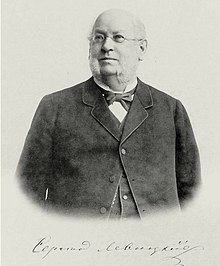Sergei Lvovich Levitsky
Sergei Lwowitsch Levizki ( Russian Сергей Львович Левицкий ; * 1819 in Moscow , † 1898 in St. Petersburg ) was a Russian photographer .
Life
Levizki was the illegitimate son of Senator Lev Alexejewitsch Jakowlew , who had become ambassador at the court of the King of Westphalia Jérôme Bonaparte after the Peace of Tilsit , and cousin Alexander Herzens . Levitsky studied at the law faculty of Moscow University with a degree in 1839 and then worked in St. Petersburg in the office of the Interior Minister Count Alexander Stroganov .
Levizki was enthusiastic about daguerreotypes and acquired a recording device in 1839. During an inspection trip in 1842 under the direction of Carl Julius Fritzsche to the Caucasus to examine the mineral waters , Levizki continued his education in the daguerreotype technique. In 1844 he took a leave of absence and traveled to Paris to improve his photographic knowledge. He attended lectures at the University of Paris and met Louis Daguerre , the American Warren T. Thompson and other photography pioneers . In 1847 a bellows camera was built based on Lewizki's drawings . At the Paris Industrial Exhibition in 1849 , Charles Chevalier received a gold medal for daguerreotypes that Levitsky had taken with his lens ( portraits , group photos, landscape photos from Pyatigorsk ). During a trip to Rome , Levitsky photographed Russian artists, including the only known photo of Nikolai Gogol .
After the February Revolution of 1848 Levizki returned to Russia and in October 1849 opened the Sergei Levizki Daguerreotype Institute on Nevsky Prospect in St. Petersburg , where the Singer House is today. Here he was the first to offer a photo studio with artificial lighting and became known as a photographer . In 1851 he received the first gold medal for photographs at the Great Exhibition . From 1852 he worked for the imperial court. In the Winter Palace he took on the couple Alexandra Feodorovna and Nicholas I , whereupon the daguerreotype was reproduced lithographically . In 1856 he photographed Alexander II's coronation in Moscow using collodion wet plates .
In 1858, Warren Thompson invited Lewizki to manage his studio in Paris, so that Lewizki returned to Paris with his family in 1859 and soon opened his own studio. From 1860 he retouched the negatives with a special pen from the company AW Faber for image processing . In 1864 he portrayed Napoleon III in Fontainebleau . and his family, whereupon Levizki photographer Emperor Napoleon III. became a member of the French Photographic Society. In 1865 he visited the Berlin photography exhibition and got to know the work of Henry Peach Robinson there.
Levizki handed over the Paris studio to his working son Rafail Sergejewitsch Levizki and returned to St. Petersburg in 1867, where he opened a new studio with a large pavilion and a special room with carbon arc lamp lighting for portraits. In 1877 Levitsky and his son were appointed court masters, and their studio was named Photographers Her Imperial Majesties Levitsky and Son .
In 1878 Levizki founded the photography department of the Russian Technology Society with Dmitri Mendeleev and Vyacheslav Sresnewski , of which he was chairman from 1886 to 1891. In the 1880s he handed over his photography facilities to his son, but remained active in the Russian Technology Society and worked as an expert or juror at many national and international photography exhibitions. 1890-1894 at the request of Alexander III: the exemplary photographic house was built for Levizki next to the Kazan Cathedral .
To Lewizkis famous works include the portraits of Nikolai Nekrasov , Ivan Turgenev , Ivan Goncharov , Vladimir Sollogub , Fyodor Tyutchev , Pyotr Vyazemsky , Vasily Botkin , Ivan Panayev , Pavel Annenkov , Dmitry Grigorovich , Alexander Herzen, Sergei Volkonsky and Leo Tolstoy .
Levitsky was buried in the St. Petersburg Smolensk Cemetery .
In 1978, the Musée d'Orsay in Paris decided to set up a photographic department with works by Lewizki. The London National Portrait Gallery soon followed, and the New York Metropolitan Museum of Art also owns some of Lewizki's works. The Russian State Film and Photo Archive opened in Krasnogorsk in 1992 and contains works by Levitsky.
Web links
Individual evidence
- ↑ Alexei Loginov: Levitsky, Sergey Lvovich . In: John Hannavy (Ed.): Encyclopedia of Nineteenth-Century Photography, Vol. 1 . Routledge, New York 2008, pp. 853-855 .
- ↑ Charlotte Zeepvat: Royal Photographers, Sergei Levitsky . In: Russia Royal Digest . tape 14 , no. 90 , p. 159 .
- ↑ David Elliott (ed.): Photography in Russia 1840-1940 . Thames and Hudson, London 1992.
- ↑ Аветян Н. Ю .: Сергей Львович Левицкий: Новые материалы к биографии фотографа . Труды Государственного Эрмитажа, St. Petersburg 2008, p. 280-301 .
- ↑ a b c d Елена Афанасьева: Левицкий Сергей Львович (accessed June 29, 2017).
| personal data | |
|---|---|
| SURNAME | Levizki, Sergei Lvowitsch |
| ALTERNATIVE NAMES | Левицкий, Сергей Львович (Russian) |
| BRIEF DESCRIPTION | Russian photographer |
| DATE OF BIRTH | 1819 |
| PLACE OF BIRTH | Moscow |
| DATE OF DEATH | 1898 |
| Place of death | St. Petersburg |
